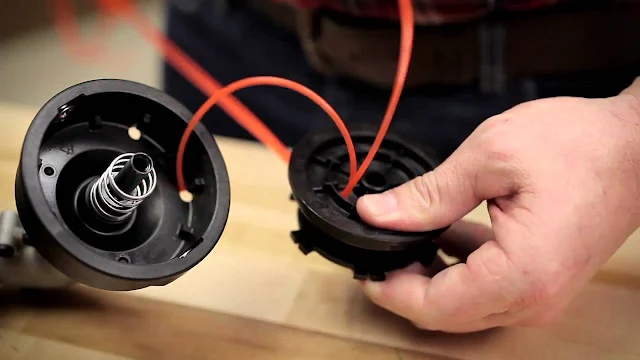🌿A Homeowner's Guide to Replacing Weed Eater String
When they're fully charged and in perfect condition, weed and grass trimmers are the best tools for putting the finishing touches on your lawn.
But there's nothing more frustrating than being in the middle of a job when the string line breaks!
Suddenly, your powerful garden tool is rendered useless. Replacing the line can be a bit tricky, but with a little guidance, you can get back to trimming in no time.
The Science of Trimmer Line: How It Works
A weed eater's "string" is actually a specialized plastic monofilament, usually made of durable nylon.
It doesn't need to be sharp like a metal lawn mower blade. Instead, it works through sheer velocity.
The trimmer head spins the line at thousands of RPM, creating enough centrifugal force to make the flexible line incredibly stiff. It's this high-speed, rigid line that acts like a whip, slicing through grass and weeds.
As the line strikes tough objects like concrete, fences, and rocks, it inevitably wears down and breaks. Most trimmers use a "bump feed" system, where you tap the head on the ground to release more line from the spool.
Newer models may even have an "auto-feed" mechanism that uses a small cutter to ensure the line is always at the perfect length for efficient cutting.
🛠️How to Replace the String on Your Weed Eater
When your line runs out, it needs to be replaced. This process can seem fiddly, but it's simple once you know the steps.
You can buy replacement string from places like Home Depot or easily order it online from Amazon.
- Safety First: Unplug your electric trimmer or remove the battery pack from a cordless model. This ensures there's zero chance of the unit accidentally starting while you're working.
- Access the Spool: Hold the trimmer upside down and locate the string spool on the head. Remove the spool cover by pressing in on the two tabs that hold it in place.
- Remove the Old Spool: Lift the empty spool off its spindle.
- Load the New Line: You have two options here. You can either slide a pre-wound replacement spool onto the trimmer, or you can refill your existing spool. To refill, insert one end of a new piece of trimmer line into the spool's anchor hole and wind the line tightly and evenly in the direction indicated by the arrows on the spool.
- Feed the Line: Thread the free end of the new line through the exit hole on the trimmer's spool housing. This can be the trickiest part, so be patient. Make sure the notch on the spool aligns with the exit hole.
- Secure the Spool: Push the newly loaded spool back into place until it clicks, indicating it's secure. Replace the spool cover, and you're ready to go!
⭐Top Trimmer Line Recommendations
The type of line you use can make a big difference. Here are some of the best options for various needs:
| Trimmer Line Name | Intended Use |
|---|---|
| Oregon Magnum Gatorline | Best for heavy weeds and thick grass. Its durable, square profile enhances cutting efficiency, making it suitable for both residential and light commercial use. |
| Arnold Maxi Edge | Ideal for cutting tall grass efficiently. Its nearly round, multi-sided profile provides superior cutting capability and durability. |
| Husqvarna Titanium Force | Designed for both trimming and edging. It's made of a commercial-grade copolymer material to handle tough conditions while remaining efficient and quiet. |
| Weed Warrior Pulverizer Twist | Suitable for yards with moderately dense grass and weeds. Its twisted design offers better durability and lower vibrations. |
| DEWALT Trimmer Line | Optimized for removing lighter weeds and grass. It's easy to install due to its flexible and impact-resistant design. |
Pro Tip: How to Edge Your Lawn with a Trimmer
A weed eater is great for creating clean, sharp edges along sidewalks and driveways. Simply turn the trimmer so the head is vertical (90 degrees to the ground).
Turn it on and slowly lower it down, letting the tip of the line cut a neat edge along the concrete. Try not to hit the concrete directly, as this will wear out your line very quickly.
It takes a little practice, but you'll get a feel for it!
Once you've mastered your yard work, perhaps it's time to reward yourself and learn how to homebrew beer!
